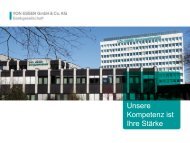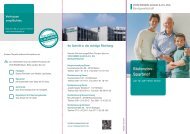2012 Registration document and annual financial report - BNP Paribas
2012 Registration document and annual financial report - BNP Paribas
2012 Registration document and annual financial report - BNP Paribas
- No tags were found...
You also want an ePaper? Increase the reach of your titles
YUMPU automatically turns print PDFs into web optimized ePapers that Google loves.
7ARESPONSIBLE BANK: INFORMATION ON <strong>BNP</strong> PARIBAS’ ECONOMIC,SOCIAL, CIVIC AND ENVIRONMENTAL RESPONSIBILITYEnvironmental responsibility: combating climate changeLIMITING THE ENVIRONMENTAL FOOTPRINT OF OUR OWN OPERATIONS7ASSESSING THE IMPACTS ANDCOMMITTING THE GROUP TO PRECISETARGETSOne of the commitments made by <strong>BNP</strong> <strong>Paribas</strong> in its CSR strategy is toreduce its direct environmental footprint.This concerns mainly the greenhouse gases (GHGs) generated bybuilding energy consumption <strong>and</strong> employee business travel, responsiblepaper consumption, <strong>and</strong> waste management (notably for obsolete ITequipment).In order to monitor the successful implementation of measures in thesethree areas, the CSR function is monitoring an environmental <strong>report</strong>ingsystem with the help of more than 150 employees in 17 countries,representing 83.7% of the full-time equivalent staff (FTEs) managed bythe Group at 31 December <strong>2012</strong>. Around forty indicators are <strong>report</strong>ed inthis campaign: kWh, m 3 of gas, km travelled, litres of water, tonnes ofpaper, tonnes of waste, etc. By extrapolating for the 16.3% not covered,the results are used to calculate the environmental data mentioned inthis section for the whole Group.In <strong>2012</strong>, more than 20,000 Group employees worked in an entity orterritory where the environmental management system is covered byISO 14 001 certification.In the three main areas (GHGs, paper <strong>and</strong> waste), the Group has drawnup internal policies <strong>and</strong> quantified objectives for 2015:■ cut GHG emissions per employee by 10% compared with <strong>2012</strong>;■ cut paper consumption per employee by 15% compared with <strong>2012</strong>;■ increase the share of responsibly sourced paper (produced fromrecycling or sustainably managed forests) to 60% of the total amountconsumed internally;■ increase the share of internal waste paper collected for recyclingto 55%;■ process obsolete IT equipment according to a rigorous policy forcontrolling the associated environmental <strong>and</strong> social risks.Employees are kept informed of the Group’s environmental policiesthrough a range of channels: dedicated Intranet pages, distribution ofinternal policies (such as the paper policy – “consume less, consumerbetter, sort more” – or the obsolete IT equipment end of life managementpolicy) <strong>and</strong> guides to ecobehaviour distributed in certain countries <strong>and</strong>businesses.The amount of provisions <strong>and</strong> guarantees covering environmental risks isUSD 3.4 million. The provision is for private litigation <strong>and</strong> is not intendedto cover penalties for non-compliance with regulations.The nature of its activities means that the Group is not a significantsource of noise pollution or any other specific form of pollution.CUT GREENHOUSE GAS EMISSIONS BY 10%PER EMPLOYEE IN 2015Greenhouse gas emissions are measured by converting the energyconsumed in buildings (heating, air conditioning, lighting, IT powersupply) <strong>and</strong> in employee business travel (air, rail, road) into tonnes ofCO 2equivalent (t CO 2-e, including all six greenhouse gases covered by theKyoto protocol). On this basis, the Group’s emissions in <strong>2012</strong> amountedto 605,644 t CO 2-e (i.e. 3.21 t CO 2-e per FTE, vs 3.39 in 2011), breakingdown into 75.7% buildings <strong>and</strong> 24.3% business travel.The quality of <strong>BNP</strong> <strong>Paribas</strong>’ environmental <strong>report</strong>ing was rated 86/100 bythe Carbon Disclosure Project in <strong>2012</strong> (compared with 79/100 in 2011),making the Group a sector leader in this area.The Group has undertaken to cut its CO 2-e/FTE ratio by 10% in 2015compared with <strong>2012</strong>, in a three-pronged approach: building energyefficiency, reduced consumption by IT equipment (including data centres)<strong>and</strong> optimisation of business travel.The Group’s energy consumption amounted to 1,751GWh in <strong>2012</strong>, vs1,950GWh in 2011. Compared with the square metreage of its buildings(offices, branches, data centres, etc), this was 227kWh/m² as against233kWh/m² in 2011. A range of initiatives is being deployed to drive downthese consumption levels. In Belgium, the Group aims to cut consumptionby 13% between 2010 <strong>and</strong> 2015. In France, energy management modulesare being deployed in all FRB branches, which, moreover, are ISO 14001certified. Wherever possible in the Group, heating <strong>and</strong> lighting systemswithin buildings are upgraded with the latest technology: in Japan, airconditioningonly kicks in at 28 °C in certain buildings; in Morocco, remoteswitching devices have reduced consumption by 15% in the branches <strong>and</strong>25% at the Head Office.Renewable energy represented 10.6% of this consumption vs 9.3% in2011. It is sourced either by buying renewable energy certificates, or fromthe direct consumption of renewable energy produced in the Group’sbuildings (photovoltaic installations on the roofs of branches of FirstHawaiian Bank, BNL in Italy; biomass boiler at a site in France, etc).418<strong>2012</strong> <strong>Registration</strong> <strong>document</strong> <strong>and</strong> <strong>annual</strong> <strong>financial</strong> <strong>report</strong> - <strong>BNP</strong> PARIBAS





